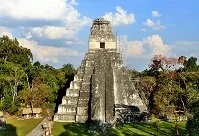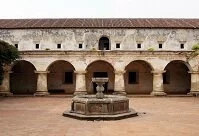Architecture of Guatemala

Tikal
Guatemala's earliest architecture is still in excellent condition as the Mayans left behind one of their greatest monuments in the city of Tikal. This city in the jungle was one of the Mayan Empire's greatest cities and to this day is a great example of Mayan architecture as well as a popular tourist destination. Other than this city and numerous smaller Mayan ruins in the country, there is little pre-Columbian architecture in the country as most early architecture was made from wood and has not lasted.

Capuchin Monastery
The Spanish arrived in the 1500s and they immediately developed new architectural styles and city planning. Their houses were built primarily from adobe, which the indigenous people used before Spanish arrival, and Spanish churches were generally in the style of churches built in Spain at the time. Most noticeably though is the urban planning the Spanish implemented as nearly every colonial city is on a grid pattern with a central square dominated by a church and government buildings. The most developed colonial Spanish city is probably the capital of Guatemala City and the National Palace on the central square is perhaps the finest colonial building in the country.